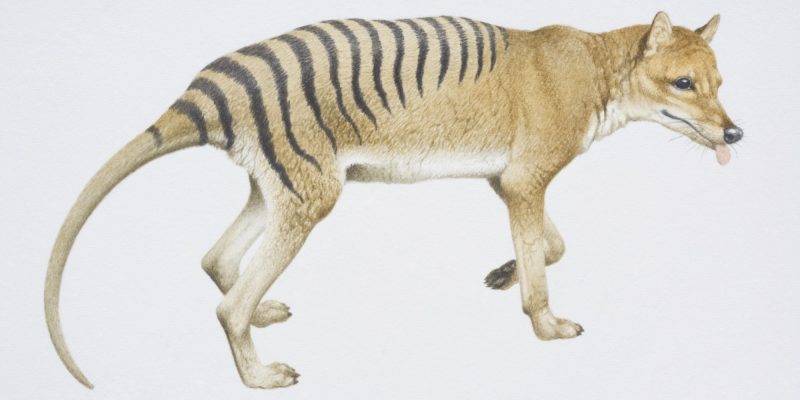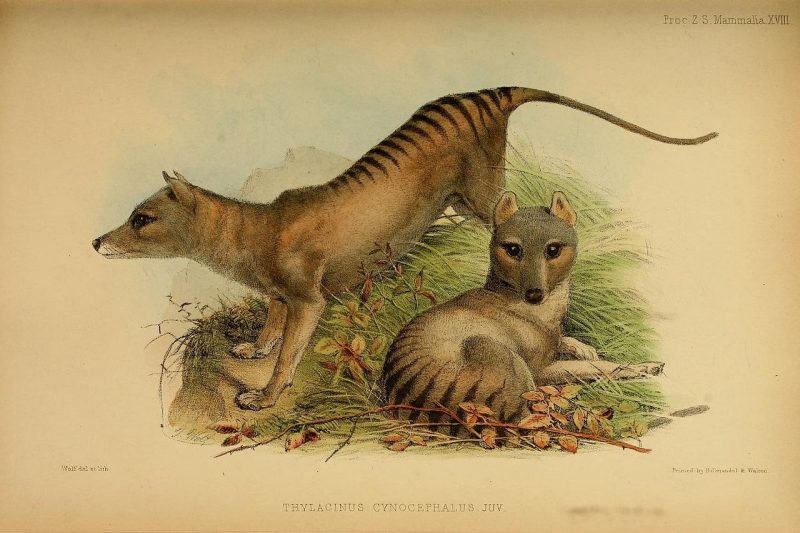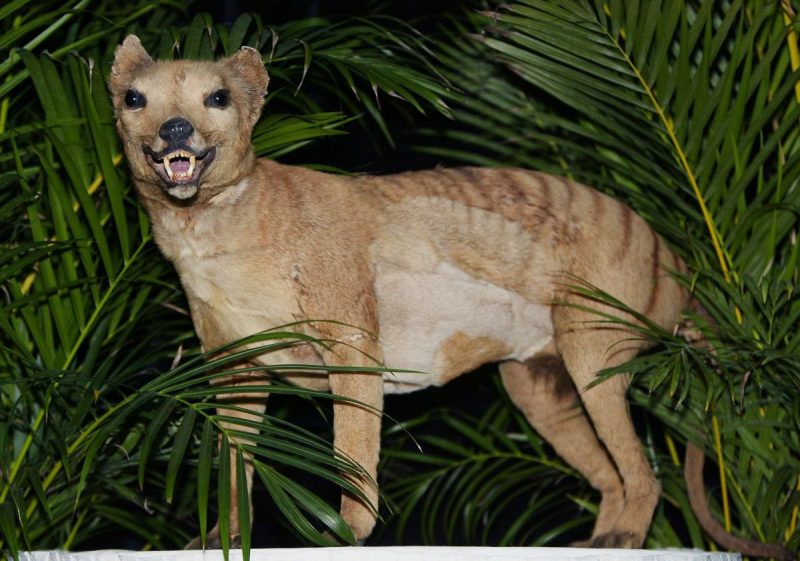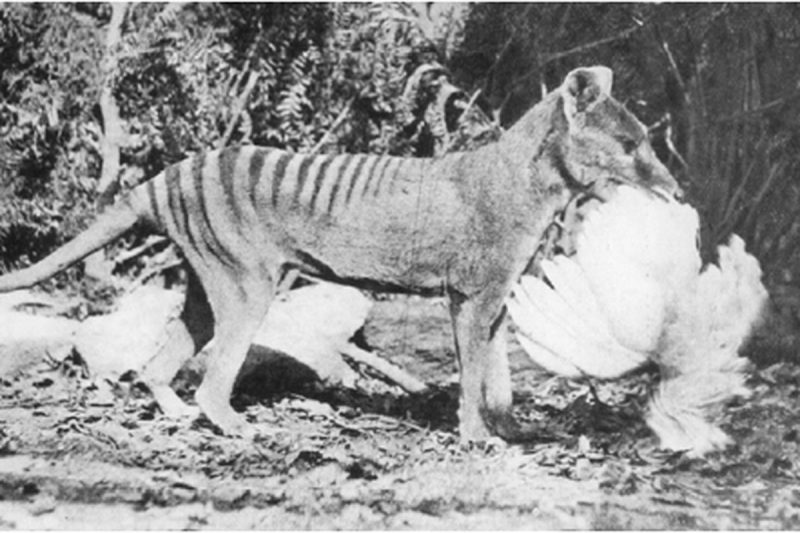Mysterious creatures and ancient animals that once inhabited our planet have long excited the curiosity of modern people. The desire to learn about them as much as possible prompted a person to conduct numerous studies and expeditions. One of the most interesting animals of the twentieth century is the Tasmanian wolf wiped from the face of the Earth.
Material Content:
Tasmanian Wolf Description
The predator, now not living on Earth, has three names - the Tasmanian or marsupial wolf and tilacin. They call him Tasmanian, paying tribute to the Dutch traveler Abel Tasman. It was he who first noticed this animal in the distant 1642. This happened on the expanses of the island, which was later renamed Tasmania.
Tilacin was recognized as the largest representative of marsupial predators. Against the background of other brethren, he stood out in size: with a weight of 29 kg, the height of the animal withers could be 60 cm, and the length of the body - 1-1.8 m (including the tail).
The opinions of the colonists regarding the name of this strange animal diverged. No amazing names of this creature were invented: it was called a tiger, hyena, zebra wolf, dog, etc. Such a variety of names was justified - amazing tilacins possessed habits and outward signs of several animals.
It is interesting! The structure of the skull of tilacin somewhat resembles a canine (for this reason, the wolf is also called dog-headed). Nevertheless, the elongated shape of both jaws forms an almost straight line, which is not characteristic of any dog in the world.
The marsupial wolf was able to cleverly climb trees.Dark brownish stripes in the amount of 12 to 19 pieces, resembling tiger ones, decorated the tail and back of a sandy color.
Where did the predators live?
About 30 million years ago, tilacins lived not only in Tasmania, but also in Australia and in the vastness of South America. At the same time, American animals disappeared about 8 million years ago, Australian animals - about 1.5 thousand years ago. Over time, tilacins firmly settled on the island of Tasmania. Here they were not bothered by natural enemies.
Gradually crowded out by man, wolves left the flat part of the island, inhabiting forests and mountains. Here the predator lived in hollows and under the roots of trees, in crevices of rocks.
Animal lifestyle
Marsupial wolves often lived alone, sometimes joining their relatives to participate in a common hunt. Tilacins were most active at night, preferring to bask in the warm sunshine or lie down in shelter at noon. Eyewitnesses often talked about the tilacins they met sleeping in the hollows of trees at an altitude of 5 m from the ground.
Modern biologists suggest that the Tasmanian wolf breeding season was in December-February, and puppies were born in the spring. The female carried the babies for 35 days. The babies were born underdeveloped and subsequently remained in the mother’s bag for another 9 months.
The mother bag itself is represented by a large pocket in the abdominal cavity, which, in essence, is a fold of the skin. This "reservoir" was opened in such a way that leaves and grass did not fall inside the bag when the female wolf switched to running.
Nutrition in the natural habitat
Marsupial predators often feasted on animals trapped in a trap.
But the basis of their menu was also vertebrates, among which were:
- echidna;
- feathered;
- wood kangaroos;
- lizards.
Tilacins did not fall before eating and fell, and preferred live prey. So, having tasted live meat, the marsupial wolf left an undernourished victim, which was later used by other animals, for example, marsupials. Individuals living in captivity have repeatedly shown their pickiness regarding the freshness of food, defiantly refusing thawed meat.
Disputes about the methods of obtaining food by predators have not yet subsided. Some biologists are sure that marsupial wolves attacked the victim from an ambush and gnawed at the base of the skull (that is, acted as representatives of the cat family). Other researchers adhere to the version that tilacins stubbornly and methodically pursued their prey until it completely exhausted its strength.
Causes of the extinction of the marsupial predator
Modern people are probably interested in the question of why tilacin died out and who was responsible for its disappearance from the face of the Earth.
There is little information about the natural enemies of the wolf. It should only be noted that the offspring that are born in predatory mammals are much more hardy and developed than the marsupials. The latter are born underdeveloped, in addition, among such babies infant mortality is much higher. For this reason, the number of even modern marsupials is growing very slowly.
It is believed that at one time tilacins did not withstand the competition of carnivorous mammals: dingo dogs, coyotes and foxes.
Only 2 factors turned out to be fatal for Tasmanian wolves: dog plague and, in fact, man. At the beginning of the last century, tilacins became massively infected with plague brought to Tasmania with domestic dogs. Thus, by 1915, the number of marsupial wolves was measured in hundreds. Over time, tilacins were accused of mass extermination of sheep on farms. Predators began to destroy.
Note. Over the years, studies of the skeleton of the marsupial wolf have shown that information about his involvement in the mass death of sheep is greatly exaggerated. The jaws of the animal were very weak in order to deal with such a large prey.
The authorities of Tasmania, which adopted the law on the protection of marsupials, for unknown reasons, did not take care of the entry into the register of endangered species of tilacin. The result was not long in coming - in 1930 in Tasmania all wild marsupial wolves were exterminated. And in 1936, in the last zoo in Australia, the last tilacin on the planet died.
Interesting facts about the Tasmanian wolf
Familiarization with the amazing extinct animals of the island of Tasmania would be incomplete without indicating particularly interesting facts about this predator:
- As if recollecting themselves, and ashamed of their recklessness (or outright stupidity), Australian officials created a document according to which hunting for Tasmanian wolves was prohibited. Only the release date of the decree is puzzling. It was created 2 years after the disappearance of the last marsupial wolf.
- Many people were convinced that marsupial predators remained alive throughout the 20th century, carefully hiding in impassable thickets of Australia. Nevertheless, with a thorough examination of their possible habitats, it became clear that tilacins are extinct animals. To believe in this fact was finally not easy, and in different years several expeditions were created, the purpose of which was to detect traces of these animals. One of them was held in the late 1930s, the other - at the beginning of the second half of the last century.
- In 2005, a prize of $ 1.25 million was instituted to anyone who caught tilacin and made it available to the public.
- The marsupial wolf possessed a stiff and long tail. Interestingly, they relied on this part of the body, like the kangaroo. Scientists are sure that due to the tail, predators could jump 2-3 meters in height.
- Since the beginning of the XXI century, scientists have made the first attempt to clone a marsupial wolf. And although this event was unsuccessful, the researchers are not discouraged. It is possible that as a result of such manipulations, the descendants of modern people will be able to see firsthand the living wolf of Tasmania.
Tilacin is an extinct species of predators that once inhabited the territory of modern Australia and Tasmania. It was wiped off the face of the Earth mainly through the fault of man. Modern scientists do not abandon attempts to clone an ancient wolf, reviving its population to life.


















